Petrogenesis of Middle Jurassic Syenite-Granite Suites and Early Cretaceous Granites with Associated Enclaves in Southwestern Zhejiang, SE China: Implications for Subduction-Related Tectonic Evolution Beneath Northeastern Cathaysia Block
Abstract
1. Introduction
2. Geological Background and Samples
3. Analytical Methods
3.1. Zircon U-Pb Dating
3.2. Whole-Rock Elemental Analysis
3.3. Sr-Nd Isotopic Analysis
3.4. Zircon Lu-Hf Isotopic Analysis
4. Results
4.1. Zircon U-Pb Ages
4.2. Whole-Rock Major Elements
4.3. Whole-Rock Trace Elements
4.4. Whole-Rock Sr-Nd Isotopic Compositions
4.5. Zircon Hf Isotopic Compositions
5. Discussion
5.1. Petrogenesis and Sources of Middle Jurassic Syenite
5.2. Petrogenesis and Sources of Middle Jurassic Alkali-Feldspar Granite
5.3. Petrogenesis of Early Cretaceous Granite and Their Intermediate Enclave
5.3.1. Early Cretaceous Granite
5.3.2. Intermediate Enclave
5.4. Implications for Crust-Mantle Interaction and Geodynamic Process
6. Conclusions
- (1)
- The Middle Jurassic alkali-feldspar granites (169 Ma) and syenites (167 Ma) both exhibit subduction-related geochemical signatures. The syenites in the NE Cathaysia formed from metasomatized lithospheric mantle, while coeval alkali-feldspar granites derived from partial melting of the basement of the Cathaysia Block.
- (2)
- The Early Cretaceous granites (134 Ma) and their intermediate enclaves (136 Ma) are high-K calc-alkaline and weakly peraluminous to metaluminous. The granites and enclaves originated from lower crustal mafic melting, with enclaves representing earlier crystallization products, which were then mechanically mixed with granite.
- (3)
- The crustal reworking of NE Cathaysia Block transitioned from Middle Jurassic subduction-driven compression to Early Cretaceous extension due to slab rollback.
Supplementary Materials
Author Contributions
Funding
Data Availability Statement
Acknowledgments
Conflicts of Interest
References
- Zhou, X.M.; Sun, T.; Shen, W.Z.; Shu, L.S.; Niu, Y.L. Petrogenesis of Mesozoic Granitoids and Volcanic Rocks in South China: A Response to Tectonic Evolution. Episodes 2006, 29, 26–33. [Google Scholar] [CrossRef] [PubMed]
- Isozaki, Y.; Aoki, K.; Nakama, T.; Yanai, S. New Insight into a Subduction-Related Orogen: A Reappraisal of the Geotectonic Framework and Evolution of the Japanese Islands. Gondwana Res. 2010, 18, 82–105. [Google Scholar] [CrossRef]
- Müller, R.D.; Seton, M.; Zahirovic, S.; Williams, S.E.; Matthews, K.J.; Wright, N.M.; Shephard, G.E.; Maloney, K.T.; Barnettmoore, N.; Hosseinpour, M. Ocean Basin Evolution and Global-Scale Plate Reorganization Events Since Pangea Breakup. Annu. Rev. Earth Planet. Sci. 2016, 44, 107–138. [Google Scholar] [CrossRef]
- Li, J.; Dong, S.; Cawood, P.A.; Zhao, G.; Johnston, S.T.; Zhang, Y.; Xin, Y. An Andean-Type Retro-Arc Foreland System Beneath Northwest South China Revealed by SINOPROBE Profiling. Earth Planet. Sci. Lett. 2018, 490, 170–179. [Google Scholar] [CrossRef]
- Li, S.Z.; Suo, Y.H.; Li, X.Y.; Zhou, J.; Santosh, M.; Wang, P.C.; Wang, G.Z.; Guo, L.L.; Yu, S.Y.; Lan, H.Y.; et al. Mesozoic Tectono-Magmatic Response in the East Asian Ocean-Continent Connection Zone to Subduction of the Paleo-Pacific Plate. Earth-Sci. Rev. 2019, 192, 91–137. [Google Scholar] [CrossRef]
- Guo, F.; Wu, Y.; Zhang, B.; Zhang, X.; Zhao, L.; Liao, J. Magmatic Responses to Cretaceous Subduction and Tearing of the Paleo-Pacific Plate in SE China: An Overview. Earth-Sci. Rev. 2021, 212, 103448. [Google Scholar] [CrossRef]
- Wang, X.L.; Liu, J.X.; Lü, Q.T.; Wang, S.; Wang, D.; Chen, X. Evolution of Deep Crustal Hot Zones Constrained by the Diversity of Late Mesozoic Magmatic Rocks in SE China. Ore Geol. Rev. 2021, 134, 104143. [Google Scholar] [CrossRef]
- Xu, X.; Zhao, K.; He, Z.; Liu, L.; Hong, W. Cretaceous Volcanic-Plutonic Magmatism in SE China and a Genetic Model. Lithos 2021, 402–403, 105728. [Google Scholar] [CrossRef]
- Yang, J.; Zhang, J.; Chen, J.; Sun, J. Mesozoic Continental Crustal Rejuvenation of South China: Insights from Zircon HfO Isotopes of Early Jurassic Gabbros, Syenites and a-Type Granites. Lithos 2021, 402–403, 105678. [Google Scholar] [CrossRef]
- He, Z.Y.; Xu, X.S. Petrogenesis of the Late Yanshanian Mantle-Derived Intrusions in Southeastern China: Response to the Geodynamics of Paleo-Pacific Plate Subduction. Chem. Geol. 2012, 328, 208–221. [Google Scholar] [CrossRef]
- Zhao, L.; Guo, F.; Zhang, X.; Wang, G. Cretaceous Crustal Melting Records of Tectonic Transition from Subduction to Slab Rollback of the Paleo-Pacific Plate in SE China. Lithos 2021, 384–385, 105985. [Google Scholar] [CrossRef]
- Xu, X.S.; Xie, X. Late Mesozoic-Cenozoic Basaltic Rocks and Crust-Mantle Interaction, SE China. Geol. J. China Univ. 2005, 11, 318–334. [Google Scholar] [CrossRef]
- Li, J.H.; Cawood, P.A.; Ratschbacher, L.; Zhang, Y.Q.; Dong, S.W.; Xin, Y.J.; Yang, H.; Zhang, P.X. Building Southeast China in the Late Mesozoic: Insights from Alternating Episodes of Shortening and Extension Along the Lianhuashan Fault Zone. Earth-Sci. Rev. 2020, 201, 103056. [Google Scholar] [CrossRef]
- Suo, Y.; Li, S.; Cao, X.; Wang, X.; Somerville, I.; Wang, G.; Wang, P.; Liu, B. Mesozoic-Cenozoic Basin Inversion and Geodynamics in East China: A Review. Earth-Sci. Rev. 2020, 210, 103357. [Google Scholar] [CrossRef]
- Xu, X.; Huang, Z.; Jiang, D.; Zeng, G.; Dai, L. Remnants and Fragments of the Subducted Paleo-Pacific Plate: Constraints From Geochemistry and Geophysics. Sci. China Earth Sci. 2024, 67, 3041–3061. [Google Scholar] [CrossRef]
- Jiang, Y.H.; Wang, G.C.; Liu, Z.; Ni, C.Y.; Qing, L.; Zhang, Q. Repeated Slab Advance–Retreat of the Palaeo-Pacific Plate Underneath SE China. Int. Geol. Rev. 2015, 57, 472–491. [Google Scholar] [CrossRef]
- Wang, Q.; Li, J.W.; Jian, P.; Zhao, Z.H.; Xiong, X.L.; Bao, Z.W.; Xu, J.F.; Li, C.F.; Ma, J.L. Alkaline Syenites in Eastern Cathaysia (South China): Link to Permian-Triassic Transtension. Earth Planet. Sci. Lett. 2005, 230, 339–354. [Google Scholar] [CrossRef]
- Li, Z.X.; Li, X.H. Formation of the 1300-Km-Wide Intracontinental Orogen and Postorogenic Magmatic Province in Mesozoic South China: A Flat-Slab Subduction Model. Geology 2007, 35, 179–182. [Google Scholar] [CrossRef]
- Meng, L.; Li, Z.; Chen, H.; Li, X.; Zhu, C. Detrital Zircon U–Pb Geochronology, Hf Isotopes and Geochemistry Constraints on Crustal Growth and Mesozoic Tectonics of Southeastern China. J. Asian Earth Sci. 2015, 105, 286–299. [Google Scholar] [CrossRef]
- Sun, T. A New Map Showing the Distribution of Granites in South China and Its Explanatory Notes. Geol. Bull. China 2006, 25, 332–335. [Google Scholar]
- Li, B.; Jiang, S.Y.; Lu, A.H.; Lai, J.Q.; Zhao, K.D.; Yang, T. Petrogenesis of Late Jurassic Granodiorites from Gutian, Fujian Province, South China: Implications for Multiple Magma Sources and Origin of Porphyry Cu–Mo Mineralization. Lithos 2016, 264, 540–554. [Google Scholar] [CrossRef]
- Li, B.; Jiang, S.Y.; Zhang, Q.; Zhao, H.X.; Zhao, K.D. Geochemistry, Geochronology and Sr–Nd–Pb–Hf Isotopic Compositions of Middle to Late Jurassic Syenite–Granodiorites–Dacite in South China: Petrogenesis and Tectonic Implications. Gondwana Res. 2016, 35, 217–237. [Google Scholar] [CrossRef]
- Jiang, S.; Zhao, K.; Jiang, Y.; Dao, B. Characteristics and Genesis of Mesozoic A-Type Granites and Associated Mineral Deposits in the Southern Hunan and Northern Guangxi Provinces along the Shi-Hang Belt, South China. Geol. J. China Univ. 2008, 14, 496–509. [Google Scholar] [CrossRef]
- Li, Z.X.; Li, X.H.; Chung, S.L.; Lo, C.H.; Xu, X.S.; Li, W.X. Magmatic Switch-On and Switch-Off Along the South China Continental Margin Since the Permian: Transition from an Andean-Type to a Western Pacific-Type Plate Boundary. Tectonophysics 2012, 532–535, 271–290. [Google Scholar] [CrossRef]
- Li, Z.; Qiu, J.S.; Yang, X.M. A Review of the Geochronology and Geochemistry of Late Yanshanian (Cretaceous) Plutons Along the Fujian Coastal Area of Southeastern China: Implications for Magma Evolution Related to Slab Break-Off and Rollback in the Cretaceous. Earth-Sci. Rev. 2014, 128, 232–248. [Google Scholar] [CrossRef]
- Liu, L.; Qiu, J.; Li, Z. Origin of Mafic Microgranular Enclaves (MMEs) and their Host Quartz Monzonites from the Muchen Pluton in Zhejiang Province, Southeast China: Implications for Magma Mixing and Crust–Mantle Interaction. Lithos 2013, 160, 145–163. [Google Scholar] [CrossRef]
- Li, Z.; Qiu, J.S.; Xu, X.S. Geochronological, Geochemical and Sr–Nd–Hf Isotopic Constraints on Petrogenesis of Late Mesozoic Gabbro–Granite Complexes on the Southeast Coast of Fujian, South China: Insights into a Depleted Mantle Source Region and Crust–Mantle Interactions. Geol. Mag. 2012, 149, 459–482. [Google Scholar] [CrossRef]
- Li, X.Y.; Li, S.Z.; Suo, Y.H.; Huang, F.; Wang, P.C.; Luan, S.R.; Zhou, J. High-Silica Rhyolites in the Terminal Stage of Massive Cretaceous Volcanism, SE China: Modified Crustal Sources and Low-Pressure Magma Chamber. Gondwana Res. 2022, 102, 133–150. [Google Scholar] [CrossRef]
- Zhu, K.Y.; Li, Z.X.; Xu, X.S.; Wilde, S.A. A Mesozoic Andean-Type Orogenic Cycle in Southeastern China as Recorded by Granitoid Evolution. Am. J. Sci. 2014, 314, 187–234. [Google Scholar] [CrossRef]
- Li, X.H.; Li, Z.X.; Li, W.X. Detrital Zircon U-Pb Age and Hf Isotope Constrains on the Generation and Reworking of Precambrian Continental Crust in the Cathaysia Block, South China: A Synthesis. Gondwana Res. 2014, 25, 1202–1215. [Google Scholar] [CrossRef]
- Yao, J.; Shu, L.; Santosh, M.; Li, J. Neoproterozoic Arc-Related Andesite and Orogeny-Related Unconformity in the Eastern Jiangnan Orogenic Belt: Constraints on the Assembly of the Yangtze and Cathaysia Blocks in South China. Precambr. Res. 2015, 262, 84–100. [Google Scholar] [CrossRef]
- Shu, L.; Yao, J.; Wang, B.; Faure, M.; Charvet, J.; Chen, Y. Neoproterozoic Plate Tectonic Process and Phanerozoic Geodynamic Evolution of the South China Block. Earth-Sci. Rev. 2021, 216, 103596. [Google Scholar] [CrossRef]
- Xu, X.S.; O’Reilly, S.Y.; Griffin, W.L.; Wang, X.; Pearson, N.J.; He, Z. The Crust of Cathaysia: Age, Assembly and Reworking of Two Terranes. Precambr. Res. 2007, 158, 51–78. [Google Scholar] [CrossRef]
- Li, X.H.; Li, W.X.; Li, Z.X.; Lo, C.H.; Wang, J.; Ye, M.F.; Yang, Y.H. Amalgamation Between the Yangtze and Cathaysia Blocks in South China: Constraints from SHRIMP U-Pb Zircon Ages, Geochemistry and Nd-Hf Isotopes of the Shuangxiwu Volcanic Rocks. Precambr. Res. 2009, 174, 117–128. [Google Scholar] [CrossRef]
- Yu, J.H.; O’Reilly, S.Y.; Zhou, M.F.; Griffin, W.L.; Wang, L.J. U-Pb Geochronology and Hf-Nd Isotopic Geochemistry of the Badu Complex, Southeastern China: Implications for the Precambrian Crustal Evolution and Paleogeography of the Cathaysia Block. Precambr. Res. 2012, 222–223, 424–449. [Google Scholar] [CrossRef]
- Yao, J.L.; Shu, L.S.; Santosh, M. Neoproterozoic Arc-Trench System and Breakup of the South China Craton: Constraints From N-MORB Type and Arc-Related Mafic Rocks, and Anorogenic Granite in the Jiangnan Orogenic Belt. Precambr. Res. 2014, 247, 187–207. [Google Scholar] [CrossRef]
- Wong, J.; Sun, M.; Xing, G.F.; Li, X.H.; Zhao, G.C.; Wong, K.; Wu, F.Y. Zircon U–Pb and Hf Isotopic Study of Mesozoic Felsic Rocks from Eastern Zhejiang, South China: Geochemical Contrast Between the Yangtze and Cathaysia Blocks. Gondwana Res. 2011, 19, 244–259. [Google Scholar] [CrossRef]
- Guo, F.; Fan, W.; Li, C.; Zhao, L.; Li, H.; Yang, J. Multi-Stage Crust–Mantle Interaction in SE China: Temporal, Thermal and Compositional Constraints from the Mesozoic Felsic Volcanic Rocks in Eastern Guangdong–Fujian Provinces. Lithos 2012, 150, 62–84. [Google Scholar] [CrossRef]
- Zhao, J.L.; Qiu, J.S.; Liu, L.; Wang, R.Q. The Late Cretaceous I- And a-Type Granite Association of Southeast China: Implications for the Origin and Evolution of Post-Collisional Extensional Magmatism. Lithos 2016, 240–243, 16–33. [Google Scholar] [CrossRef]
- Li, Z.L.; Zhou, J.; Mao, J.R.; Santosh, M.; Yu, M.G.; Li, Y.Q.; Hu, Y.Z.; Langmuir, C.H.; Chen, Z.X.; Cai, X.X. Zircon U-Pb Geochronology and Geochemistry of Two Episodes of Granitoids from the Northwestern Zhejiang Province, SE China: Implication for Magmatic Evolution and Tectonic Transition. Lithos 2013, 179, 334–352. [Google Scholar] [CrossRef]
- Zhou, J.; Jin, C.; Suo, Y.; Li, S.; Zhang, L.; Liu, Y.; Wang, G.; Wang, P.; Dai, L.; Santosh, M. The Yanshanian (Mesozoic) Metallogenesis in China Linked to Crust-Mantle Interaction in the Western Pacific Margin: An Overview From the Zhejiang Province. Gondwana Res. 2022, 102, 95–132. [Google Scholar] [CrossRef]
- Shao, X.; Jin, C.; Jia, B.; Liu, Y.; Pan, F.; Zhu, Z. Genesis of the Panjia Wu-Cu-Mo Deposit: Evidence from the Geochemistry and Geochronology of the Datongkeng Pluton, Northeast South China Block. Geol. J. 2020, 55, 1064–1084. [Google Scholar] [CrossRef]
- Wiedenbeck, M.; Allé, P.; Corfu, F.; Griffin, W.L.; Meier, M.; Oberli, F.; Quadt, A.V.; Roddick, J.C.; Spiegel, W. Three Natural Zircon Standards for U-Th-Pb, Lu-Hf, Trace Element and REE Analyses. Geostand. Geoanal. Res. 1995, 19, 1–23. [Google Scholar] [CrossRef]
- Sláma, J.; Košler, J.; Condon, D.J.; Crowley, J.L.; Gerdes, A.; Hanchar, J.M.; Horstwood, M.S.A.; Morris, G.A.; Nasdala, L.; Norberg, N.; et al. Plešovice Zircon—A New Natural Reference Material for U–Pb and Hf Isotopic Microanalysis. Chem. Geol. 2008, 249, 1–35. [Google Scholar] [CrossRef]
- Li, X.Y.; Li, S.Z.; Suo, Y.H.; Dai, L.M.; Guo, L.L.; Ge, F.J.; Lin, P.J. Late Cretaceous Basalts and Rhyolites from Shimaoshan Group in Eastern Fujian Province, SE China: Age, Petrogenesis, and Tectonic Implications. Int. Geol. Rev. 2018, 60, 1721–1743. [Google Scholar] [CrossRef]
- Thirlwall, M.F. Long-Term Reproducibility of Multicollector Sr and Nd Isotope Ratio Analysis. Chem. Geol. Isot. Geosci. Sect. 1991, 94, 85–104. [Google Scholar] [CrossRef]
- Chen, F.K.; Satir, M.; Ji, J.; Zhong, D. Nd–Sr–Pb Isotopes of Tengchong Cenozoic Volcanic Rocks from Western Yunnan, China: Evidence for an Enriched-Mantle Source. J. Asian Earth Sci. 2002, 21, 39–45. [Google Scholar] [CrossRef]
- Hu, Z.C.; Liu, Y.S.; Gao, S.; Liu, W.; Zhang, W.; Tong, X.R.; Lin, L.; Zong, K.Q.; Li, M.; Chen, H.; et al. Improved in Situ Hf Isotope Ratio Analysis of Zircon Using Newly Designed X Skimmer Cone and Jet Sample Cone in Combination with the Addition of Nitrogen by Laser Ablation Multiple Collector ICP-MS. J. Anal. At. Spectrom. 2012, 27, 1391–1399. [Google Scholar] [CrossRef]
- Blichert-Toft, J.; Albarède, F. The Lu-Hf Isotope Geochemistry of Chondrites and the Evolution of the Mantle-Crust System. Earth Planet. Sci. Lett. 1997, 148, 243–258. [Google Scholar] [CrossRef]
- Scherer, E.; Münker, C.; Mezger, K. Calibration of the Lutetium-Hafnium Clock. Science 2001, 293, 683–687. [Google Scholar] [CrossRef]
- Siégel, C.; Bryan, S.E.; Allen, C.M.; Gust, D.A. Use and abuse of zircon-based thermometers: A critical review and a recommended approach to identify antecrystic zircons-ScienceDirect. Earth-Sci. Rev. 2018, 176, 87–116. [Google Scholar] [CrossRef]
- Lim, H.; Nebel, O.; Weinberg, R.F.; Nebel-Jacobsen, Y.; Barrote, V.R.; Park, J.; Myeong, B.; Cawood, P.A. Lower crustal hot zones as zircon incubators: Inherited zircon antecryts in diorites from a mafic mush reservoir. Geol. Soc. Lond. Spec. Publ. 2023, 537, 411–433. [Google Scholar] [CrossRef]
- Dahlquist, J.A.; Morales Cámera, M.M.; Moreno, J.A.; Basei, M.A.S.; da Cruz, G.S.; Oliveira, E.P. A conceptual model for the evolution of a magmatic system based on U-Pb zircon studies on the Devonian granites of Sierra de San Luis, Argentina. Int. Geol. Rev. 2024, 66, 1794–1814. [Google Scholar] [CrossRef]
- Maniar, P.D.; Piccoli, P.M. Tectonic Discrimination of Granitoids. Geol. Soc. Am. Bull. 1989, 101, 635–643. [Google Scholar] [CrossRef]
- Wang, Y.; Zeng, Q.; Zhang, S.; Chen, P.; Gao, S. Spatial-Temporal Relationships of Late Mesozoic Granitoids in Zhejiang Province, Southeast China: Constraints on Tectonic Evolution. Int. Geol. Rev. 2018, 60, 1529–1559. [Google Scholar] [CrossRef]
- Tang, Y.; Li, X.; Xie, Y.; Liu, L.; Lan, T.; Meffre, S.; Huang, C. Geochronology and Geochemistry of Late Jurassic Adakitic Intrusions and Associated Porphyry Mo–Cu Deposit in the Tongcun Area, East China: Implications for Metallogenesis and Tectonic Setting. Ore Geol. Rev. 2017, 80, 289–308. [Google Scholar] [CrossRef]
- Jia, S.H.; Zhao, Y.Y.; Wang, Z.Q.; Wu, Y.D.; Wang, T.; Chen, L. Zircon U–Pb Dating and Geochemical Characteristics of Granodiorite-Porphyry in the Linghou Copper Deposit, Western Zhejiang, and Their Geological Significance. Acta Geol. Sin. 2014, 88, 2071–2085. [Google Scholar]
- Chen, S.Q. Discussion on the Yanshan Epoch Rock Characteristics and Ore-Forming Background in Zhejiang Kaihua Region. Master’s Thesis, China University of Geosciences, Beijing, China, 2011. [Google Scholar]
- Tang, Y.; Li, X.; Xie, Y.; Huang, C.; Wei, H.; Cai, J.; Qin, C.; Liu, R. Geology, Geochemistry, and Genesis of the Tongcun Porphyry Mo (Cu) Deposit, NW Zhejiang Province, China. Acta Geol. Sin. (Engl. Ed.) 2014, 88, 614–615. [Google Scholar] [CrossRef]
- Zhang, J.F.; Jie, H.S.; Xu, X.M.; Gong, R. Geological and Geochemical Characteristics and Tectonic and Prospecting Significance of the Shanxi-Guangshan Intrusions in Lizhu Area, Zhejiang Province. Geol. China 2013, 40, 403–413. [Google Scholar]
- Yang, S.; Jiang, S.; Zhao, K.; Jiang, Y.; Ling, H.; Luo, L. Geochronology, Geochemistry and Tectonic Significance of Two Early Cretaceous a-Type Granites in the Gan-Hang Belt, Southeast China. Lithos 2012, 150, 155–170. [Google Scholar] [CrossRef]
- Li, Y.; Wei, J.; Chen, H.; Tan, J.; Fu, L.; Wu, G. Origin of the Maoduan Pb–Zn–Mo Deposit, Eastern Cathaysia Block, China: Geological, Geochronological, Geochemical, and Sr–Nd–Pb–S Isotopic Constraints. Miner. Depos. 2012, 47, 763–780. [Google Scholar] [CrossRef]
- McDonough, W.F.; Sun, S.S. The Composition of the Earth. Chem. Geol. 1995, 120, 223–253. [Google Scholar] [CrossRef]
- He, Z.Y.; Xu, X.S.; Niu, Y.L. Petrogenesis and Tectonic Significance of a Mesozoic Granite-Syenite-Gabbro Association from Inland South China. Lithos 2010, 119, 621–641. [Google Scholar] [CrossRef]
- Ying, J.F.; Zhang, H.F.; Tang, Y.J. Crust–Mantle Interaction in the Central North China Craton During the Mesozoic: Evidence from Zircon U–Pb Chronology, Hf Isotope and Geochemistry of Syenitic–Monzonitic Intrusions from Shanxi Province. Lithos 2011, 125, 449–462. [Google Scholar] [CrossRef]
- Sun, Y.; Xiao, L.; Zhan, Q.Y.; Wu, J.X.; Zhu, D.; Huang, W.; Bai, M.; Zhang, Y.H. Petrogenesis of the Kuangshancun and Hongshan Intrusive Complexes from the Handan–Xingtai District: Implications for Iron Mineralization Associated with Mesozoic Magmatism in the North China Craton. J. Asian Earth Sci. 2015, 113, 1162–1178. [Google Scholar] [CrossRef]
- Class, C.; le Roex, A.P. Ce Anomalies in Gough Island Lavas—Trace Element Characteristics of a Recycled Sediment Component. Earth Planet. Sci. Lett. 2008, 265, 475–486. [Google Scholar] [CrossRef]
- Plank, T.; Langmuir, C.H. Tracing Trace Elements from Sediment Input to Volcanic Output at Subduction Zones. Nature 1993, 362, 739–743. [Google Scholar] [CrossRef]
- Yang, H.; Zhang, H.; Xiao, W.; Tao, L.; Gao, Z.; Luo, B.; Zhang, L. Multiple Early Paleozoic Granitoids from the Southeastern Qilian Orogen, NW China: Magma Responses to Slab Roll-Back and Break-Off. Lithos 2021, 380–381, 105910. [Google Scholar] [CrossRef]
- Whalen, J.B.; Currie, K.L.; Chappell, B.W. A-Type Granites: Geochemical Characteristics, Discrimination and Petrogenesis. Contrib. Mineral. Petrol. 1987, 95, 407–419. [Google Scholar] [CrossRef]
- Patiño Douce, A.E. What do Experiments Tell Us about the Relative Contributions of Crust and Mantle to the Origin of Granitic Magmas? Geol. Soc. Lond. Spec. Publ. 1999, 168, 55–75. [Google Scholar] [CrossRef]
- Chappell, B.W.; White, A.J.R. Two Contrasting Granite Types: 25 Years Later. Aust. J. Earth Sci. 2001, 48, 489–499. [Google Scholar] [CrossRef]
- Gao, P.; Zheng, Y.F.; Zhao, Z.F. Experimental melts from crustal rocks: A lithochemical constraint on granite petrogenesis. Lithos 2016, 266–267, 133–157. [Google Scholar] [CrossRef]
- Chen, J.Y.; Yang, J.H.; Zhang, J.H.; Sun, J.F.; Wilde, S.A. Petrogenesis of the Cretaceous Zhangzhou Batholith in Southeastern China: Zircon U–Pb Age and Sr–Nd–Hf–O Isotopic Evidence. Lithos 2013, 162–163, 140–156. [Google Scholar] [CrossRef]
- Jiang, Y.H.; Ling, H.F.; Jiang, S.Y.; Fan, H.H.; Shen, W.Z.; Ni, P. Petrogenesis of a Late Jurassic Peraluminous Volcanic Complex and its High-Mg, Potassic, Quenched Enclaves at Xiangshan, Southeast China. J. Petrol. 2005, 46, 1121–1154. [Google Scholar] [CrossRef]
- McLeod, C.L.; Davidson, J.P.; Nowell, G.M.; de Silva, S.L.; Schmitt, A.K. Characterizing the Continental Basement of the Central Andes: Constraints from Bolivian Crustal Xenoliths. Geol. Soc. Am. Bull. 2013, 125, 985–997. [Google Scholar] [CrossRef]
- Chen, J.; Yang, J.; Zhang, J.; Sun, J. Diachronous Slab-Driven Early Cretaceous Crustal Extension and Pulsed Magmatic Response in Southeastern China: Insight From a-Type Granite and Related Rocks. Gondwana Res. 2024, 126, 22–39. [Google Scholar] [CrossRef]
- Sun, W.D.; Ding, X.; Hu, Y.H.; Li, X.H. The Golden Transformation of the Cretaceous Plate Subduction in the West Pacific. Earth Planet. Sci. Lett. 2007, 262, 533–542. [Google Scholar] [CrossRef]
- Ye, H.M.; Mao, J.R.; Zhao, X.L.; Liu, K.; Chen, D.D. Revisiting Early–Middle Jurassic Igneous Activity in the Nanling Mountains, South China: Geochemistry and Implications for Regional Geodynamics. J. Asian Earth Sci. 2013, 72, 108–117. [Google Scholar] [CrossRef]
- Liang, X.Q.; Fan, W.M.; Wang, Y.J.; Li, X.H. Early Mesozoic, Post-collisional Shoshonitic Lamprophyres along the Western Margin of the South China Orogen: Geochemical Characteristics and Tectonic Implications. Int. Geol. Rev. 2006, 48, 311–328. [Google Scholar] [CrossRef]
- Liu, Q.; Yu, J.; Su, B.; Wang, Q.; Tang, H.F.; Xu, H.; Cui, X. Discovery of the 187Ma Granite in Jincheng Area, Fujian Province: Constraint on Early Jurassic Tectonic Evolution of Southeastern China. Acta Petrol. Sin. 2011, 27, 3575–3589. [Google Scholar]
- Xing, X.L. Chronology and Petrogenesis of Jurassic-Cretaceous Volcanism in the Area of Zhejiang-Fujian Boundary. Master’s Thesis, Chengdu University of Technology, Chengdu, China, 2016. [Google Scholar]
- Xing, X.L.; Xing, G.F.; Chen, S.Z.; Zhao, X.L.; Duan, Z. LA-ICP-MS Zircons U-Pb Ages and Geological Characteristics of Early-Middle Jurassic Volcanic Rocks in the Qingyuan Area, Zhejiang Province. Geol. Bull. China 2017, 36, 1583–1590. [Google Scholar]
- Li, C.L.; Wang, Z.X.; Wang, D.X.; Cao, W.T.; Yu, X.Q.; Zhou, G.Z.; Gao, W.L. Crust–Mantle Interaction Triggered by Oblique Subduction of the Pacific Plate: Geochronological, Geochemical, and Hf Isotopic Evidence from the Early Cretaceous Volcanic Rocks of Zhejiang Province, Southeast China. Int. Geol. Rev. 2014, 56, 1732–1753. [Google Scholar] [CrossRef]
- Chen, Q.; Cheng, H.; Liu, P.; Sun, M. Late Cretaceous Basalts in the Eastern South China Block: The Result of Slab Tearing During Retreating Subduction of the Paleo-Pacific Plate. J. Asian Earth Sci. 2024, 261, 105979. [Google Scholar] [CrossRef]
- Liu, L.; Qiu, J.S.; Zhao, J.L.; Yang, Z.L. Geochronological, Geochemical, and Sr–Nd–Hf Isotopic Characteristics of Cretaceous Monzonitic Plutons in Western Zhejiang Province, Southeast China: New Insights into the Petrogenesis of Intermediate Rocks. Lithos 2014, 196, 242–260. [Google Scholar] [CrossRef]
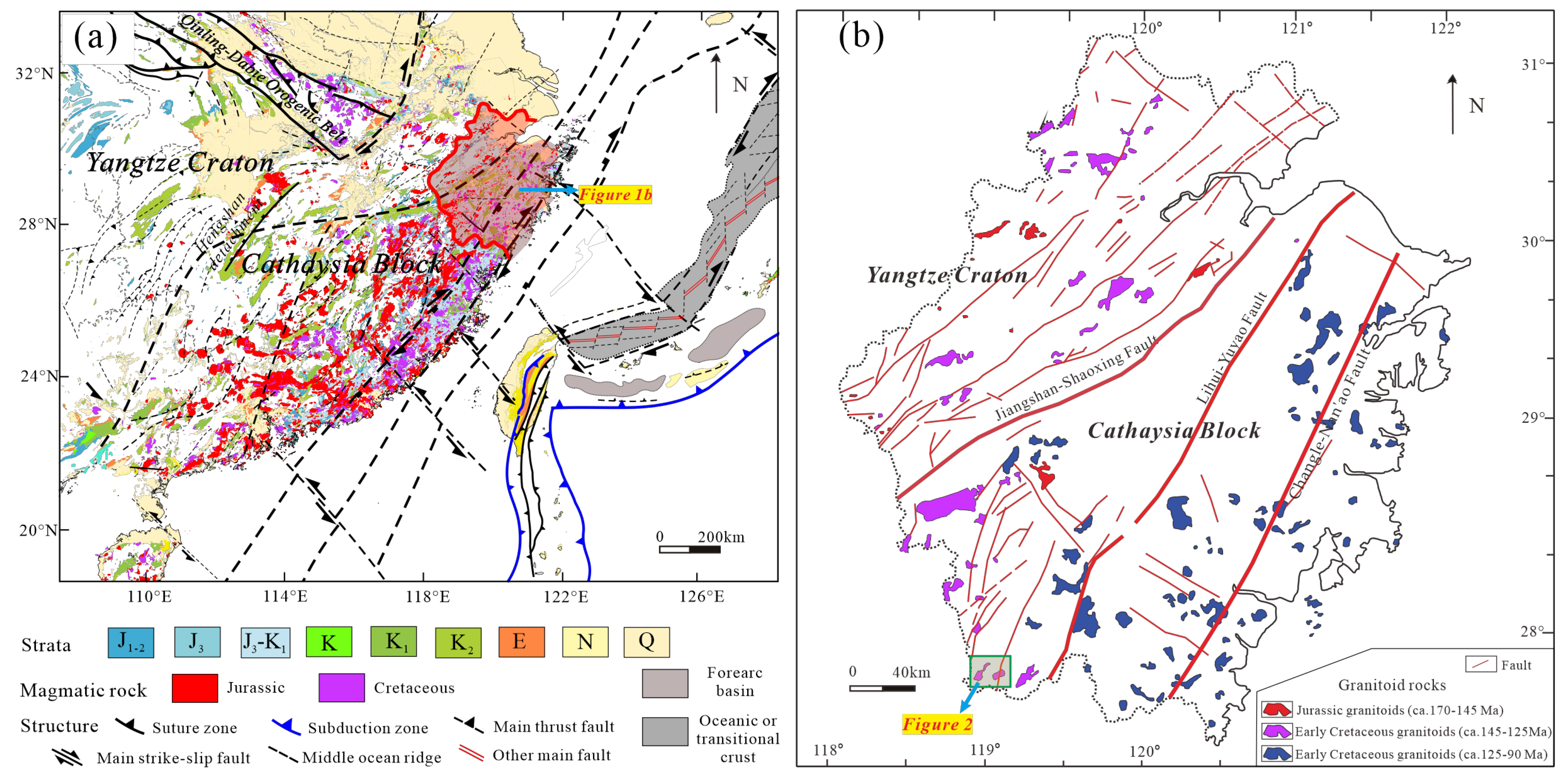

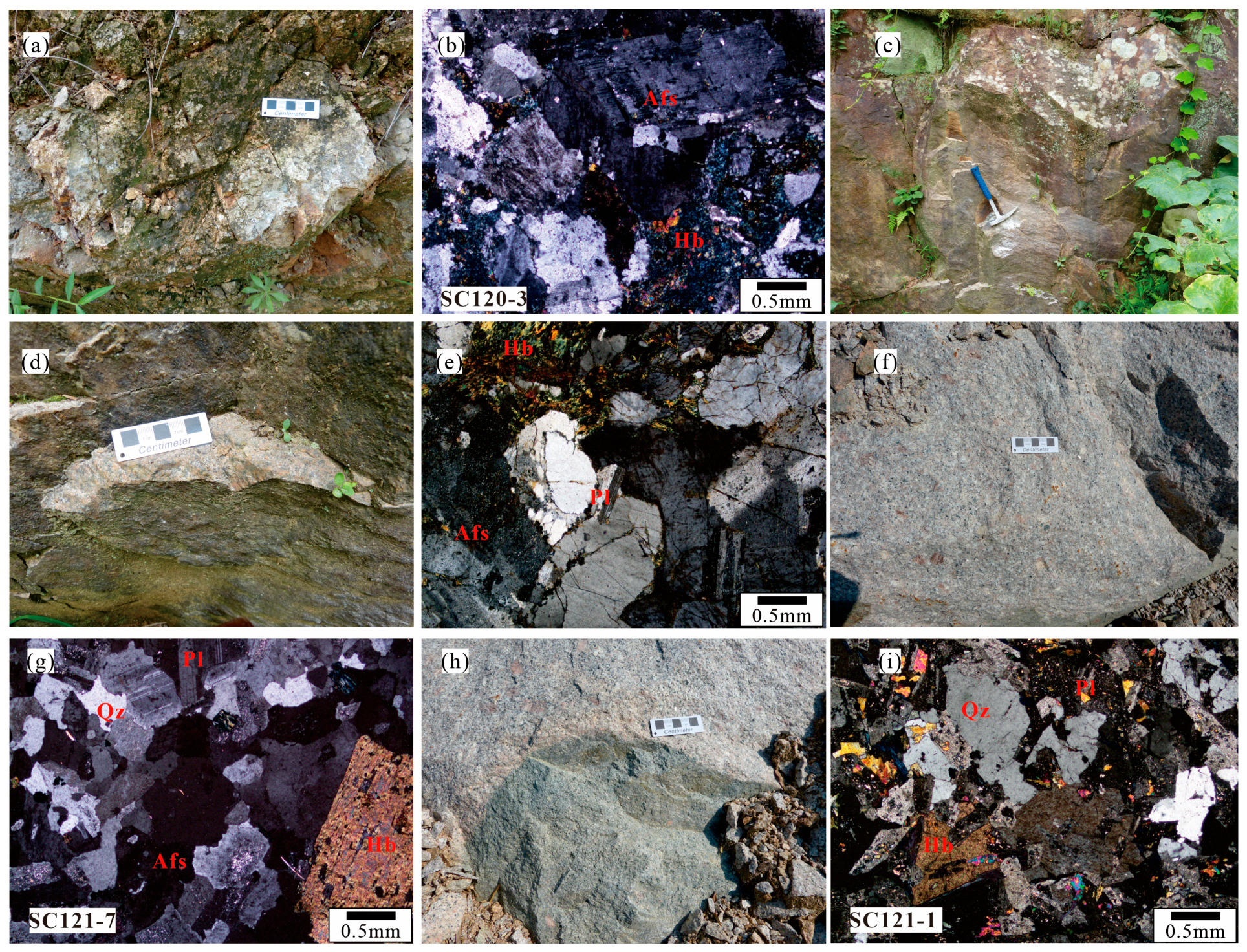
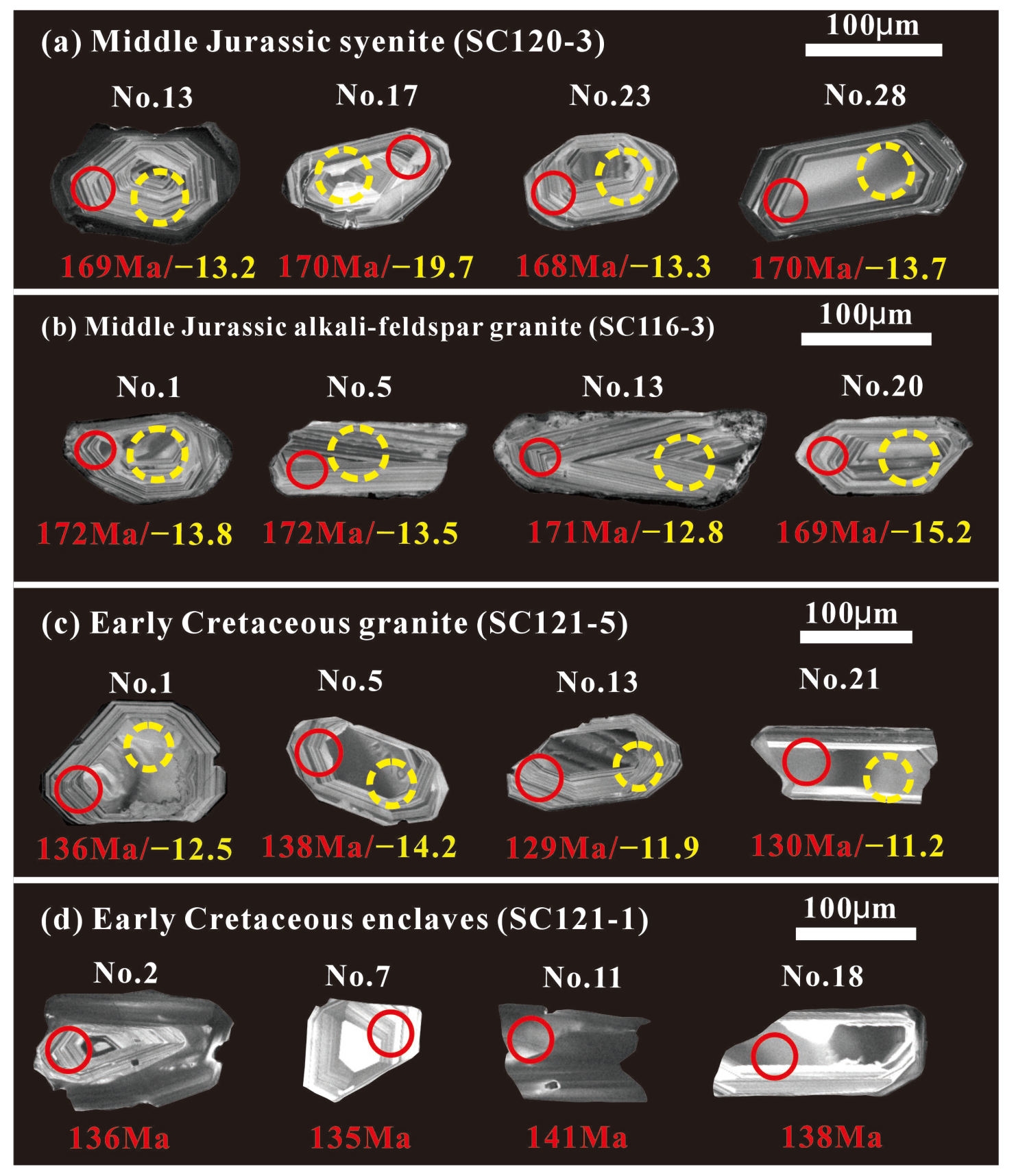
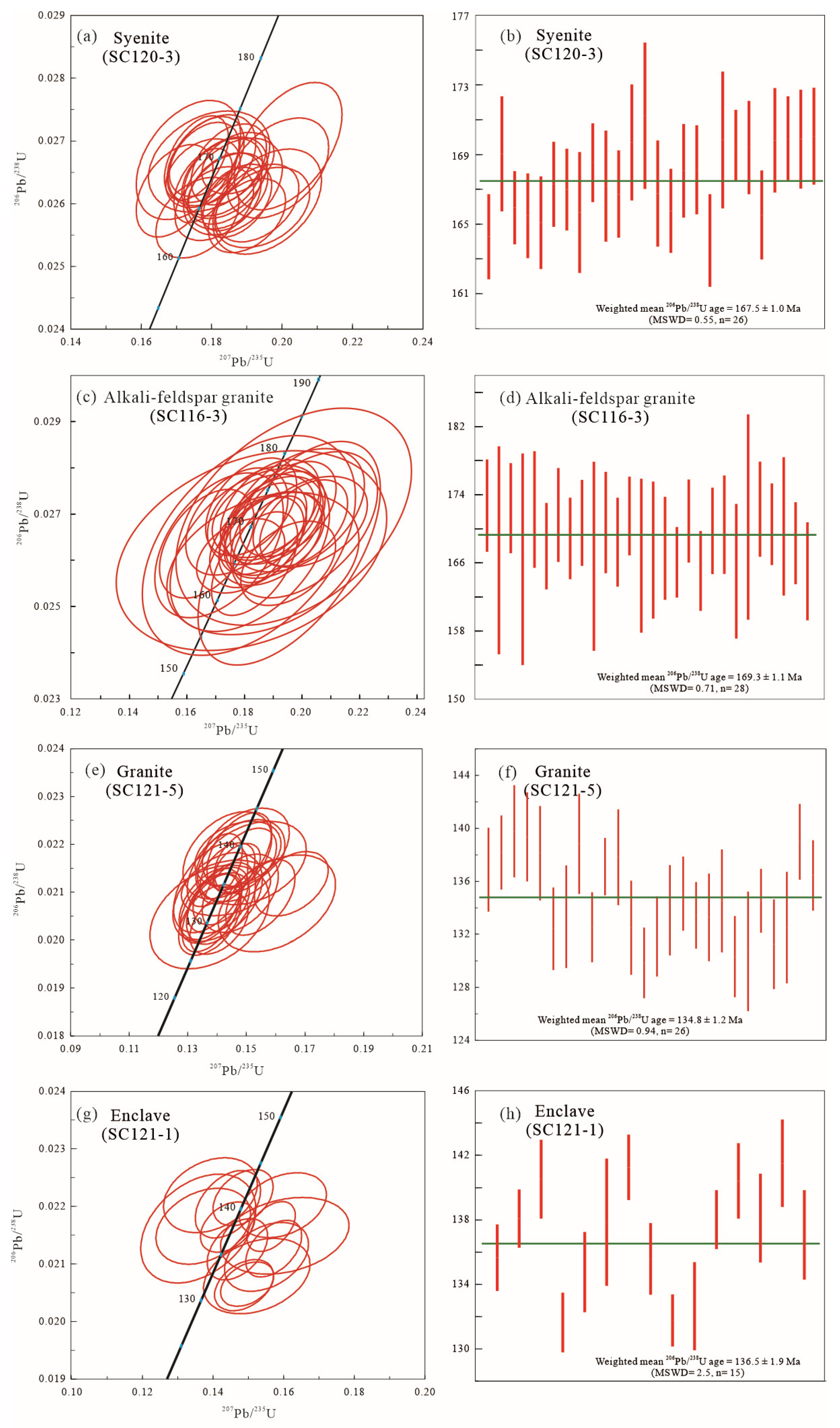
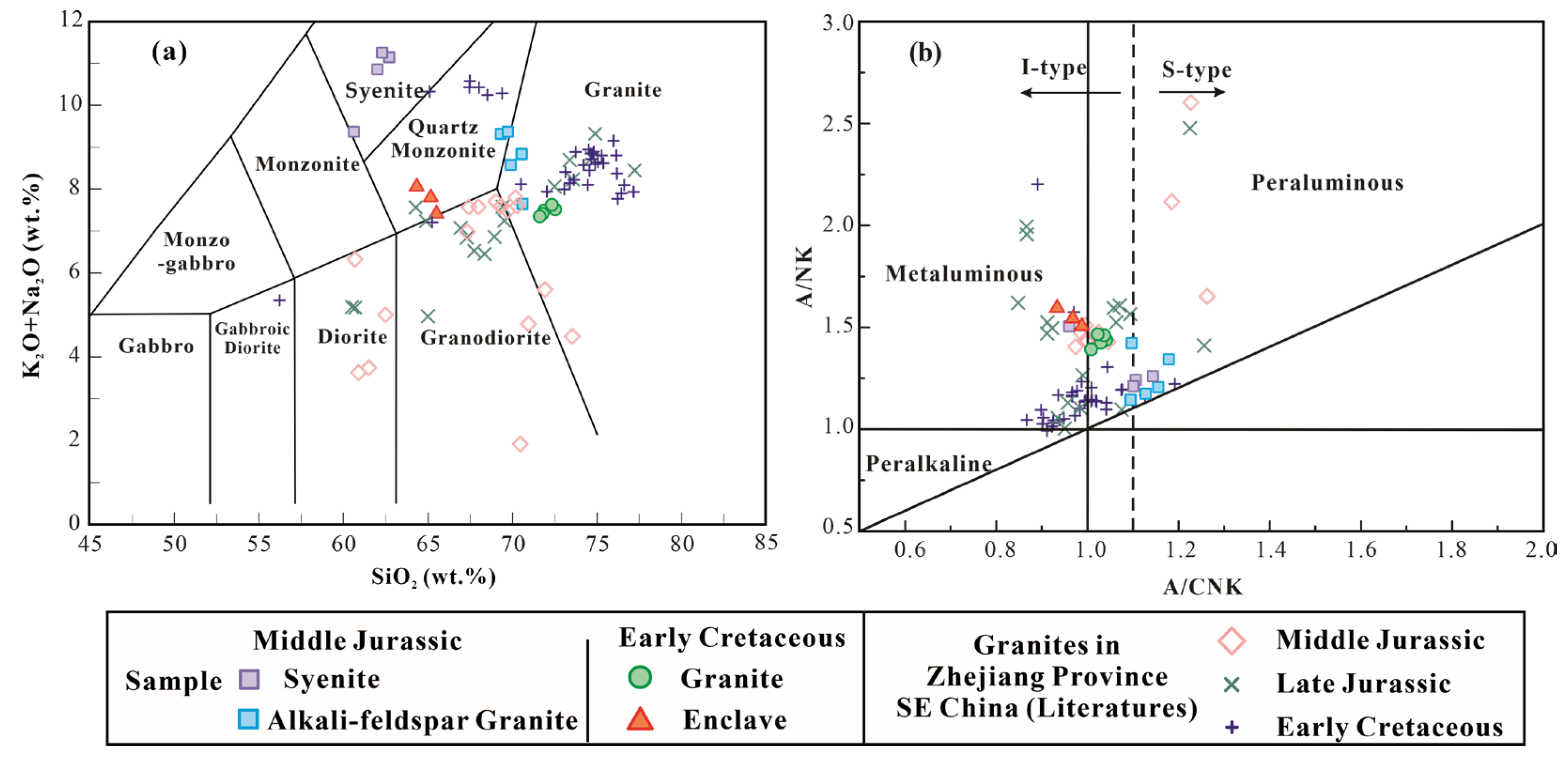
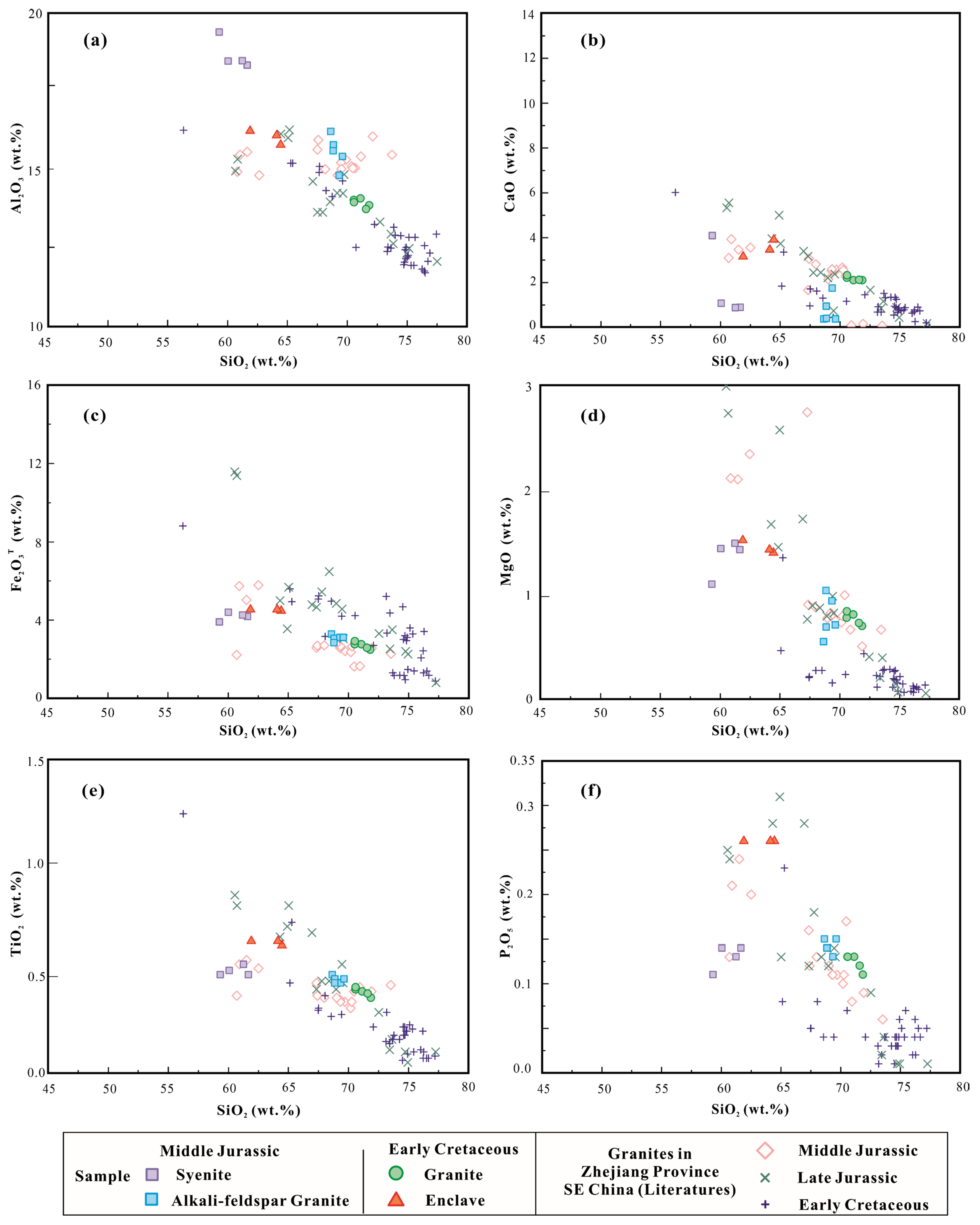
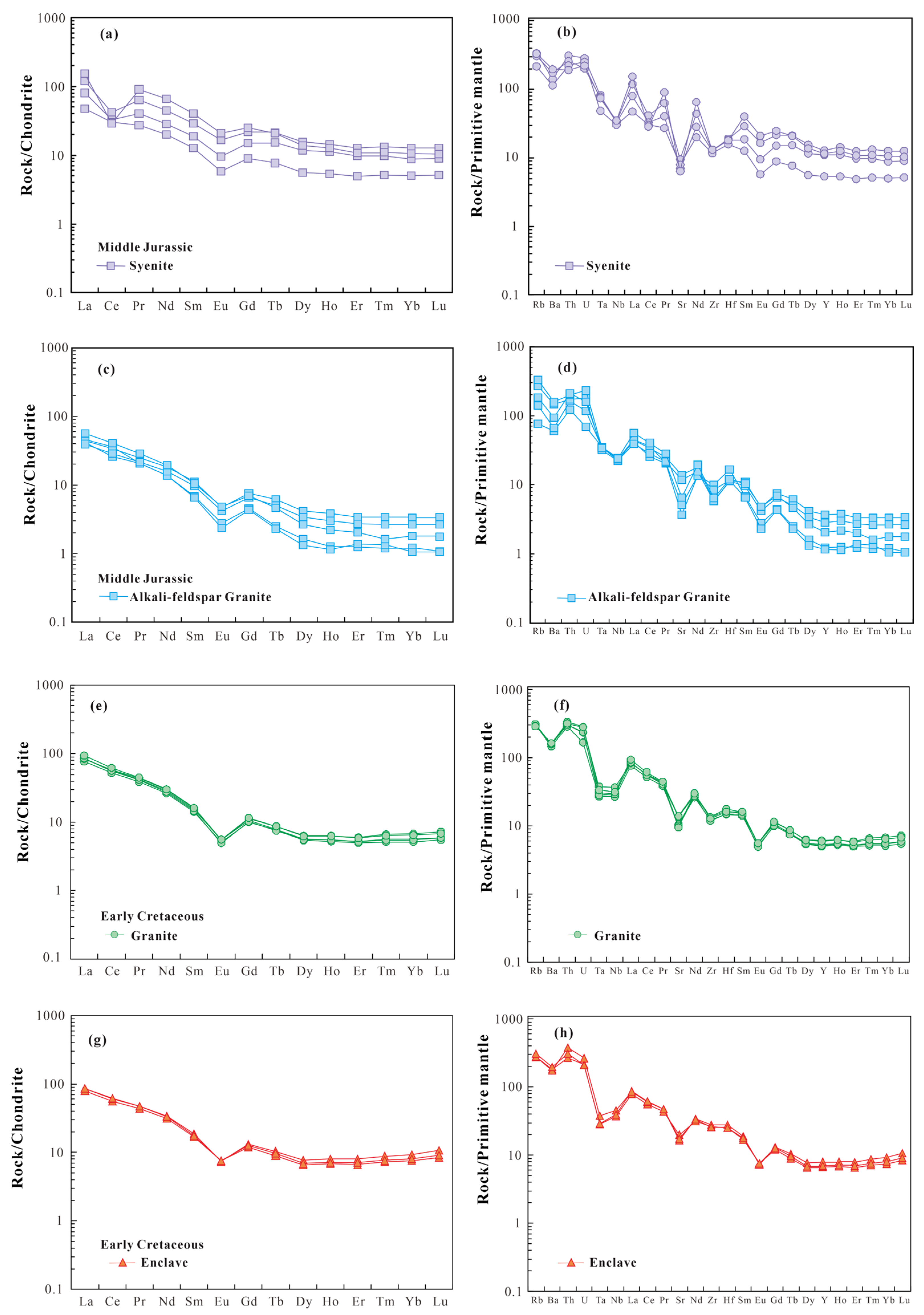
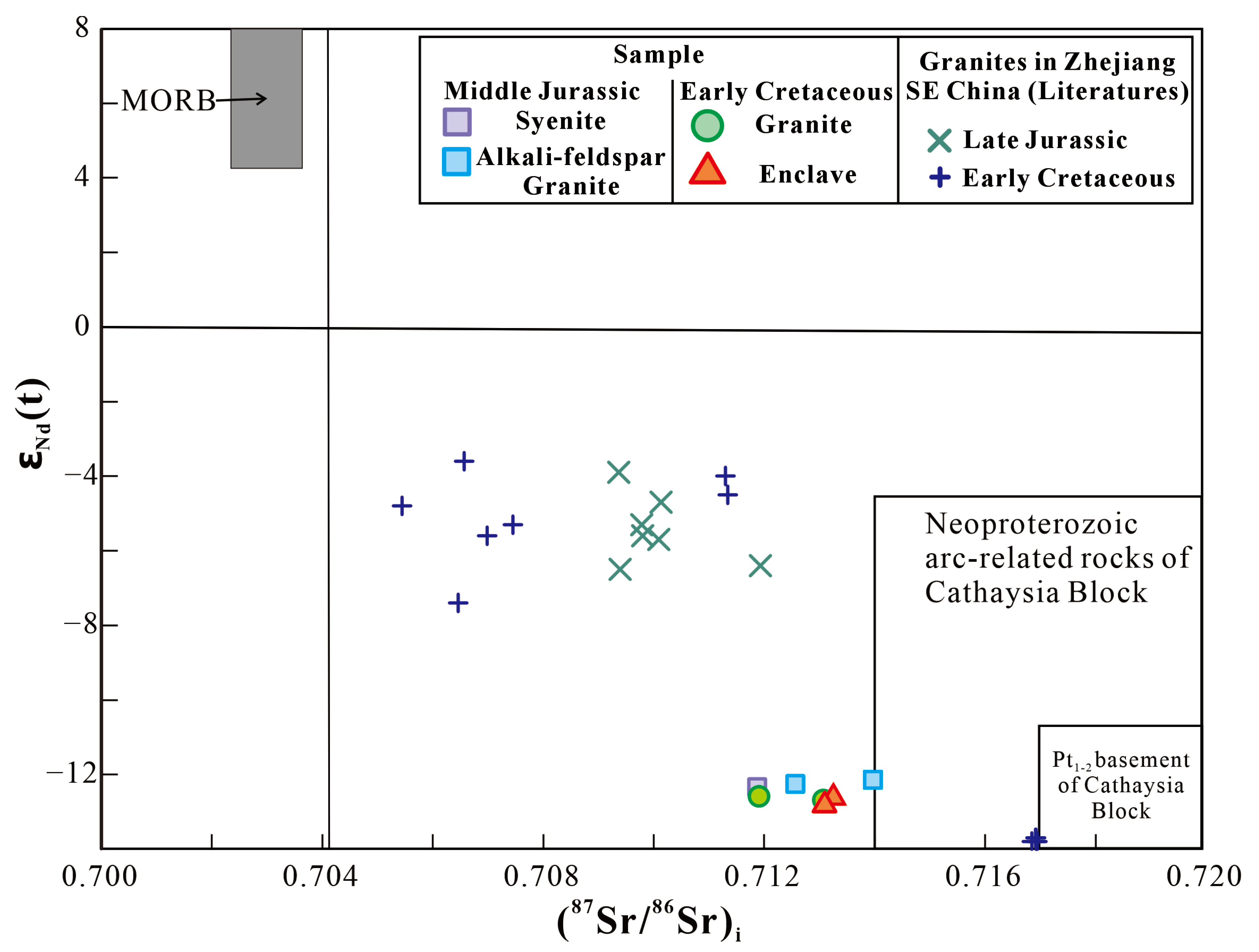
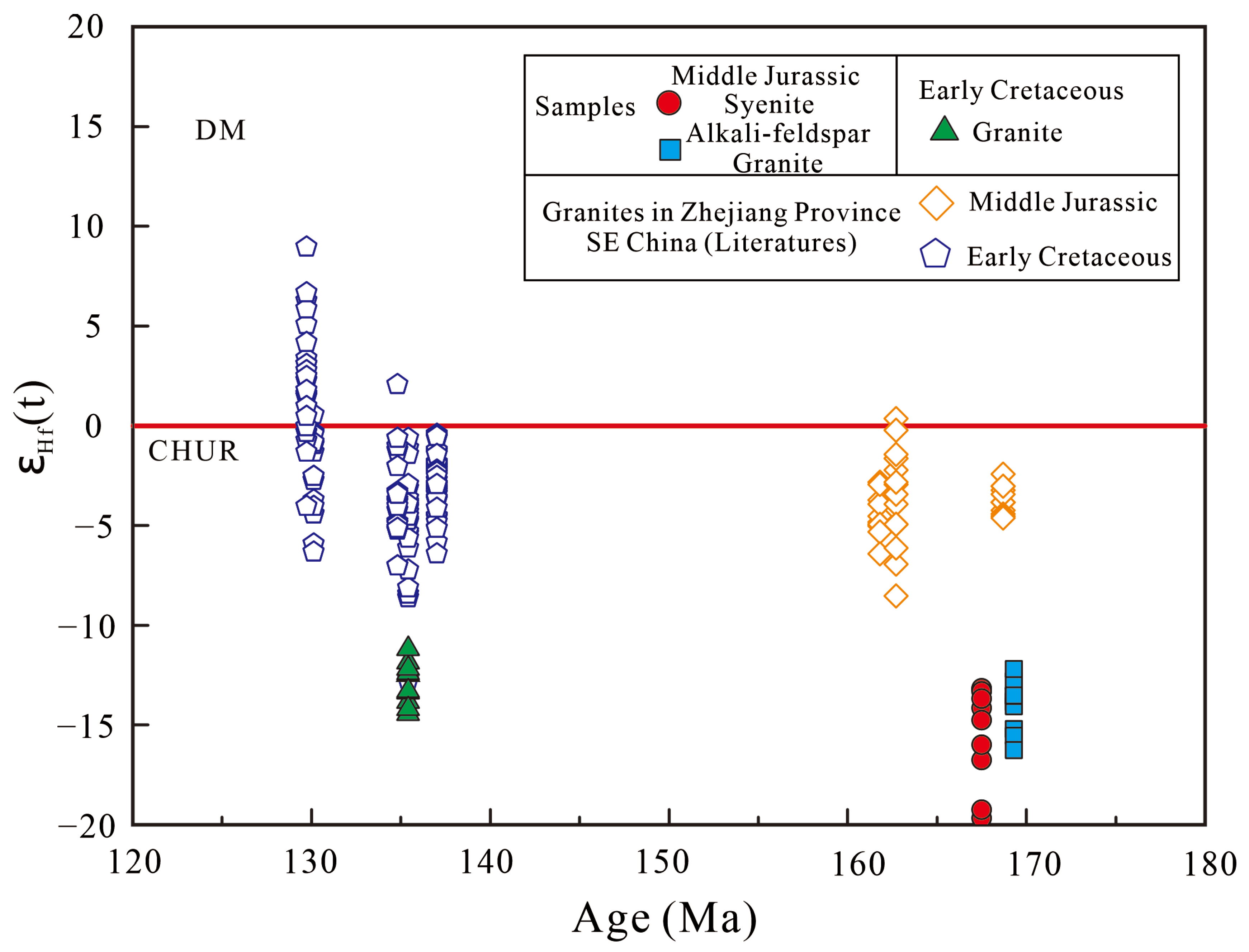



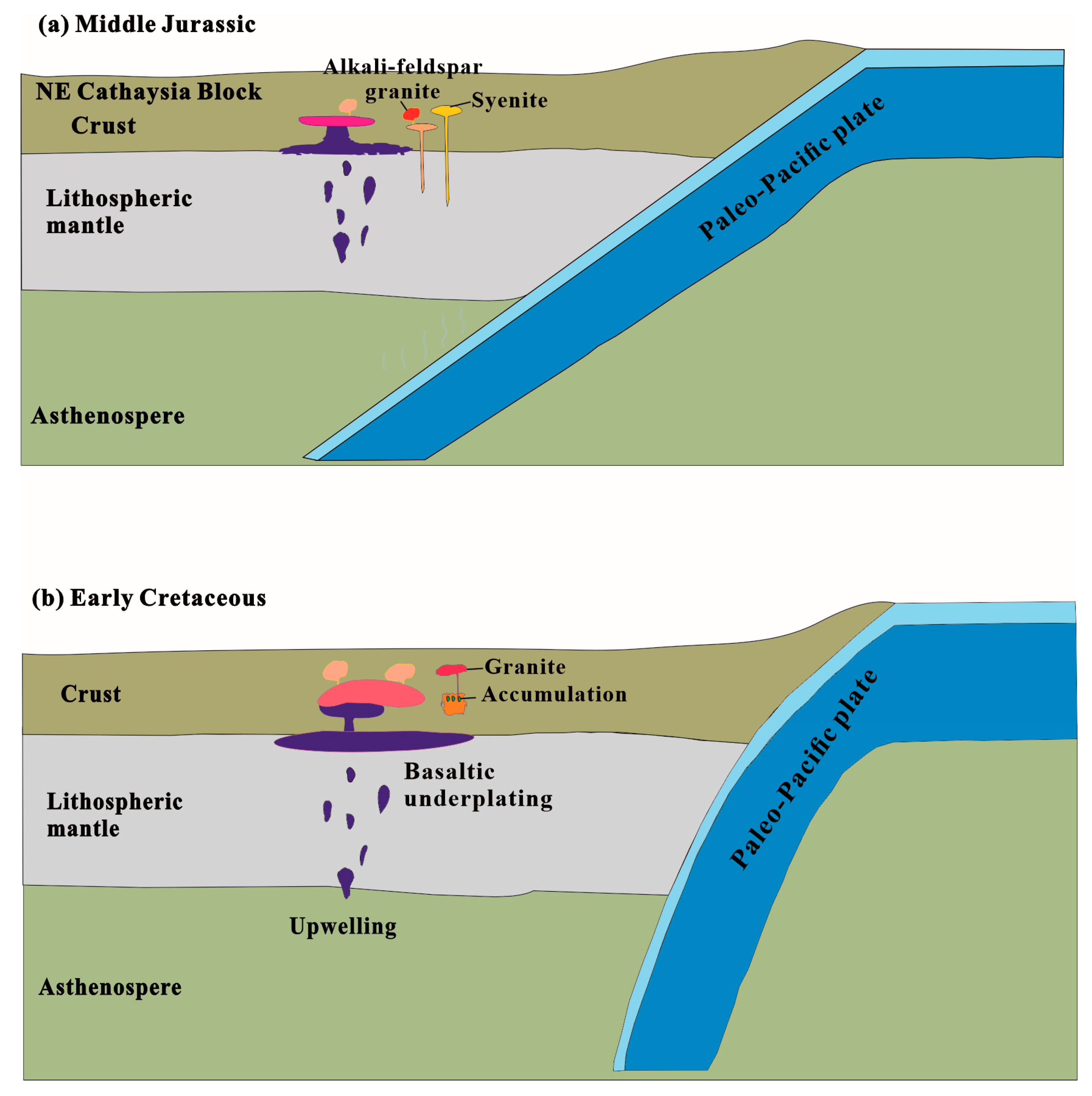
Disclaimer/Publisher’s Note: The statements, opinions and data contained in all publications are solely those of the individual author(s) and contributor(s) and not of MDPI and/or the editor(s). MDPI and/or the editor(s) disclaim responsibility for any injury to people or property resulting from any ideas, methods, instructions or products referred to in the content. |
© 2025 by the authors. Licensee MDPI, Basel, Switzerland. This article is an open access article distributed under the terms and conditions of the Creative Commons Attribution (CC BY) license (https://creativecommons.org/licenses/by/4.0/).
Share and Cite
Wang, Y.; Lan, H.; Jin, C.; Zhang, Y. Petrogenesis of Middle Jurassic Syenite-Granite Suites and Early Cretaceous Granites with Associated Enclaves in Southwestern Zhejiang, SE China: Implications for Subduction-Related Tectonic Evolution Beneath Northeastern Cathaysia Block. Minerals 2025, 15, 474. https://doi.org/10.3390/min15050474
Wang Y, Lan H, Jin C, Zhang Y. Petrogenesis of Middle Jurassic Syenite-Granite Suites and Early Cretaceous Granites with Associated Enclaves in Southwestern Zhejiang, SE China: Implications for Subduction-Related Tectonic Evolution Beneath Northeastern Cathaysia Block. Minerals. 2025; 15(5):474. https://doi.org/10.3390/min15050474
Chicago/Turabian StyleWang, Yu, Haoyuan Lan, Chong Jin, and Yuhuang Zhang. 2025. "Petrogenesis of Middle Jurassic Syenite-Granite Suites and Early Cretaceous Granites with Associated Enclaves in Southwestern Zhejiang, SE China: Implications for Subduction-Related Tectonic Evolution Beneath Northeastern Cathaysia Block" Minerals 15, no. 5: 474. https://doi.org/10.3390/min15050474
APA StyleWang, Y., Lan, H., Jin, C., & Zhang, Y. (2025). Petrogenesis of Middle Jurassic Syenite-Granite Suites and Early Cretaceous Granites with Associated Enclaves in Southwestern Zhejiang, SE China: Implications for Subduction-Related Tectonic Evolution Beneath Northeastern Cathaysia Block. Minerals, 15(5), 474. https://doi.org/10.3390/min15050474





